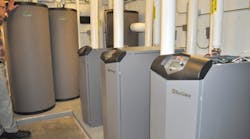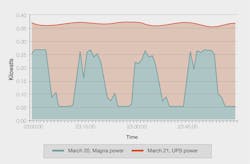At Holton Community Hospital in rural Holton, Kan., two cast-iron atmospheric boilers and three gas-fired water heaters that had been in place for nearly 20 years were operating inefficiently. With input from Charlie Griffin and Mark Law of Topeka, Kan.-based PCI Mechanical Services and Knowles Smith of Lenexa, Kan.-based Associated Equipment Sales, hospital management chose to install a new system from Lochinvar.
Based on the boiler-plate outputs and firing rates of the existing boilers and domestic water heaters at design conditions and outputs, three Knight XL heating boilers with inputs of 500,000 Btuh, two 119-gal. Squire indirect water heaters, and a 119-gal. buffer tank were selected.
PCI removed the existing equipment and installed the new system without disrupting service.
“The installation was very quick and easy,” Law said. “The Smart System operating control on the Knight XL boiler really simplifies setup, and this job was no exception.”
On one of the Knight XL heating boilers, a Grundfos MAGNA3 variable-speed circulator pump was installed. The boiler controls the speed of the pump using the built-in Smart System. When the boiler modulates down, the pump slows to maintain a constant temperature rise across the heat exchanger at all times. Reducing pump revolutions reduces power consumption tremendously.
Monitoring equipment was placed on both the lead boiler and the member boiler not dedicated to domestic water. The lead boiler had the MAGNA3 40-80 F variable-speed circulator pump, while the member boiler used the UPS 43-100 F constant-speed circulator pump.
For analysis, the team compared two similar days, March 20 and 21, at a time when only the two monitored boilers would be running. At that time, domestic water use would be unlikely, reducing the chance the third boiler would fire and affect the measured values. Figure 1 shows the power consumed by the constant-speed circulator and the variable-speed circulator when each was the lead.
Pump-speed modulation resulted in significant energy savings. The MAGNA3 reached a maximum power usage of 270 W, but slowed to a minimum of just over 50 W, while the UPS ran at a continuous 365 W. Over the course of the hour, the MAGNA3 averaged 156 W.
With Smart System, the boiler adjusts the flow through its heat exchanger to control delta-T as well as system median temperature. Delta-T across the boiler is constant, resulting in enhanced building comfort, increased heat transfer, and electricity savings.
In January 2014, Holton Community Hospital spent a total of $1,207.31 on gas and electricity. In comparison, the hospital’s gas and electricity bills for January 2013 were $2,805.41—more than twice as much.
“We could not be more pleased with our new Lochinvar system,” Stephen McCaleb, facility maintenance specialist for Holton Community Hospital, said. “This state-of-the-art equipment far exceeds our expectations at providing heating and domestic hot water to our 37,000-plus-sq-ft facility, not to mention the remarkable energy savings. The complete new system resides in the footprint of the two old atmospheric boilers, and with the removal of the three water heaters, we were pleased to have the additional space in the mechanical room.”
For Design Solutions author guidelines, call Scott Arnold, executive editor, at 216-931-9980, or write to him at [email protected].











